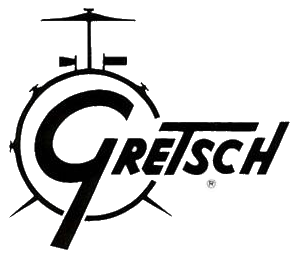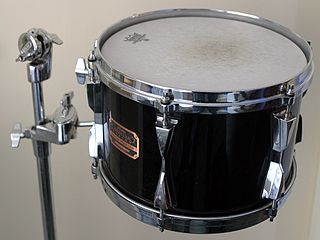
A drum kit is a collection of drums, cymbals, and sometimes other auxiliary percussion instruments set up to be played by one person. The drummer typically holds a pair of matching drumsticks or special wire or nylon brushes; and uses their feet to operate hi-hat and bass drum pedals.

The vibraphone is a percussion instrument in the metallophone family. It consists of tuned metal bars and is typically played by using mallets to strike the bars. A person who plays the vibraphone is called a vibraphonist,vibraharpist, or vibist.

A drumhead or drum skin is a membrane stretched over one or both of the open ends of a drum. The drumhead is struck with sticks, mallets, or hands, so that it vibrates and the sound resonates through the drum.
C. G. Conn Ltd., Conn Instruments or commonly just Conn, is a former American manufacturer of musical instruments incorporated in 1915. It bought the production facilities owned by Charles Gerard Conn, a major figure in early manufacture of brasswinds and saxophones in the USA. Its early business was based primarily on brass instruments, which were manufactured in Elkhart, Indiana. During the 1950s the bulk of its sales revenue shifted to electric organs. In 1969 the company was sold in bankruptcy to the Crowell-Collier-MacMillan publishing company. Conn was divested of its Elkhart production facilities in 1970, leaving remaining production in satellite facilities and contractor sources.
Slingerland is a United States manufacturer of drums. The company was founded in 1912 and enjoyed several decades of prominence in the industry before the 1980s. After ceasing operation in the early 1980s, Slingerland was acquired by Gibson, who briefly revived it and owned it until November 2019, before selling Slingerland to DW Drums, who announced the intention of re-launching the brand. Slingerland is strongly associated with jazz drummers, such as Gene Krupa and Buddy Rich, who played signature instruments made by the company. Although primarily known for its drums, in the 1930s Slingerland also produced electric and acoustic guitars, violins, mandolins, banjos and ukuleles.

Ludwig Drums is a United States musical instrument manufacturer, focused on percussion. It is a subsidiary of Conn-Selmer.
Conn-Selmer, Inc. is an American manufacturer of musical instruments for concert bands, marching bands and orchestras. It is a wholly owned subsidiary of Steinway Musical Instruments and was formed in 2003 by combining the Steinway properties, The Selmer Company and United Musical Instruments.

Big Bertha is a bass drum used by the Longhorn Band of The University of Texas at Austin. The Big Bertha name was chosen to evoke the famous German Big Bertha howitzer and has been used for two Texas bass drums, with the second debuting in 2022. Both Big Berthas have laid claim to being the largest bass drum in the world.

Remo Inc. is an American musical instruments manufacturing company based in Valencia, California, and founded by Remo Belli in 1957. Products manufactured include drum kits, drumheads, drums, and hardware, and various percussion instruments.

The Purdue "All-American" Marching Band is the marching band of Purdue University and performs at Purdue Boilermakers football games. The AAMB is also the official band of the Indianapolis 500 race, having held the position since 1919.

The Purdue Big Bass Drum is a percussion instrument played by the All-American Marching Band (AAMB) of Purdue University. At a height of over ten feet when the carriage is included, it is branded by Purdue as the "World's Largest Drum". Since its inception, it has become a lasting symbol of the marching band as well as the university. The drum can be seen at all Purdue home football games as well as parades, alumni rallies, the Indianapolis 500 Race, and many other special events.
Steinway Musical Instruments, Inc. is a worldwide musical instrument manufacturing and marketing conglomerate, based in Astoria, New York, the United States. It was formed in a 1995 merger between the Selmer Industries and Steinway Musical Properties, the parent company of Steinway & Sons piano manufacturers. From 1996 to 2013, Steinway Musical Instruments was traded at the New York Stock Exchange (NYSE) under the abbreviation LVB, for Ludwig van Beethoven. It was acquired by the Paulson & Co. private capital firm in 2013.

Gretsch Drums is a division of American musical instrument manufacturer Gretsch. The company was founded in Brooklyn, New York, in 1883. Gretsch drum kits have been used by many notable drummers including Max Roach, Tony Williams, Art Blakey, Vinnie Colaiuta, Mark Guiliana, Phil Collins, Charlie Watts, Taylor Hawkins, Mitch Mitchell and Steve Ferrone.

A tom drum is a cylindrical drum with no snares, named from the Anglo-Indian and Sinhala language. It was added to the drum kit in the early part of the 20th century. Most toms range in size between 6 and 20 inches in diameter, though floor toms can go as large as 24 inches (61 cm).
Walberg and Auge is a United States drum kit and hardware manufacturer established in 1903 in Worcester, Massachusetts by Barney Walberg. Walberg and Auge is considered by some to be, "the biggest unknown name in the history of twentieth-century American percussion." The brand is credited with several innovations in musical instruments and associated hardware including the development of the modern hi-hat stand and shell-mounted tom-tom holder. The magazine Modern Drummer detailed the origin story of the modern hi-hat configuration: "After months of experimenting, Walberg's company extended the inner rod and outer tube of his low hat stand to about waist high so he could play the cymbals with his hand as well as his feet." The pivotal innovation was sold by every major drum company under the rubric "Perfection Hats."

Paul Spotts Emrick was the first full-time director of the Purdue All-American Marching Band. He became director while still a student at Purdue University in 1905, and then served as full-time director from 1908 to 1954.
















